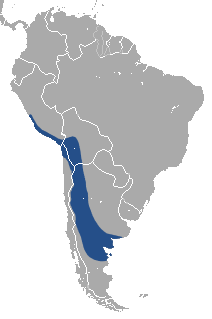White-bellied fat-tailed mouse opossum facts for kids
Quick facts for kids White-bellied fat-tailed mouse opossum |
|
|---|---|
| Conservation status | |
| Scientific classification | |
| Genus: |
Thylamys
|
| Species: |
pallidior
|
 |
|
| White-bellied fat-tailed mouse opossum range | |
| Synonyms | |
|
List
Didelphys elegans pallidior Trouessart, 1905
Marmosa bruchi Thomas, 1921 M. elegans pallidior Thomas, 1902 M. pallidior Tate, 1933 M. pulchella Cabrera, 1958 M. pusilla bruchi Cabrera, 1958 M. pusilla pallidor Cabrera, 1958 Thylamys pusilla bruchi Cabrera, 1958 T. pusilla pallidor Cabrera, 1958 |
|
The white-bellied fat-tailed mouse opossum (Thylamys pallidior) is a small animal that looks a bit like a mouse, but it's actually a type of opossum. It belongs to the family called Didelphidae. You can find this interesting creature in countries like Argentina, Bolivia, Chile, and Peru in South America.
Contents
About Its Name and Family
The white-bellied fat-tailed mouse opossum is part of a group of animals called Thylamys. It belongs to the Didelphidae family, which includes all opossums. An English zoologist named Oldfield Thomas first described it in 1902. He gave it the name Marmosa elegans pallidior back then. Later, in 1989, scientists suggested its current scientific name, Thylamys pallidior. There are no different types (subspecies) of this opossum.
The first part of its scientific name, Thylamys, comes from two Greek words: thylas, meaning "pouch," and mys, meaning "mouse." The second part, pallidior, comes from the Latin word pallidus, which means "pale." This is because its face is lighter than its body.
People sometimes call this animal by other names, such as the pallid fat-tailed opossum, comadreja enana, comadrejita comun, llaca de la puna, or marmosa palada.
What It Looks Like
The white-bellied fat-tailed mouse opossum is one of the smallest opossums in its group. It has a coat that is gray to brown, and its belly is completely white. It has clear, dark rings around its eyes that go down towards its nose. Other opossums like the buff-bellied, elegant, and Tate's fat-tailed mouse opossums have similar eye rings.
Its body, from head to tail, is about 7.3 to 10.5 centimetres (2.9 to 4.1 in) long. Its tail is a bit longer, ranging from 9 to 11.5 centimetres (3.5 to 4.5 in). Adult opossums weigh between 13 and 39 grams (0.46 and 1.38 oz).
Its fur is smooth and has a mix of gray and brown hairs. The fur along its back is darker than on its sides. Its face is much paler than the rest of its body, which is why it's called "pale." The tail can grab things (it's prehensile) and has only a few hairs, but they are the same color as its body. In the autumn, its tail gets noticeably thicker, especially near the base. This is where the opossum stores fat to help it survive the winter. The fur on its feet is white and quite thick around its ankles.
Where It Lives and Its Home
The white-bellied fat-tailed mouse opossum lives in southern Peru and southwestern Bolivia. You can also find it in the northern parts of Chile and along the eastern slopes of the Andes mountains in western and central Argentina.
It likes to live in dry and semi-dry places, from sea level up to 4,500 metres (14,800 ft) high. These areas include the coastal deserts of Peru, the Andes mountains, the Monte Desert, and the Patagonian steppe in Argentina. It usually lives in rocky areas with not many plants. However, it can also be found in dry forests or areas with thorny bushes.
Behavior
White-bellied fat-tailed mouse opossums are nocturnal animals, meaning they are active at night. They are good climbers but usually prefer to stay on the ground. They make their homes in natural spaces, like holes in trees or bushes, or under rocks.
Even though they don't truly hibernate (a deep, long sleep through winter), they can go into a state called torpor. This happens if the temperature drops below about 15 °C. During torpor, their body temperature and activity slow down a lot. This means they might be inactive for much of the winter.
In the wild, they rarely need to drink water because they get enough from the food they eat. They eat many different insects and spiders. They especially like beetles and can eat up to twenty beetles in one night! While small insects are most of their diet, they also eat some leaves and seeds. Sometimes, they even eat small animals like mice and lizards. Their main predators are birds like the barn owl and the Magellanic horned owl.
Reproduction and Life Cycle
Scientists believe that white-bellied fat-tailed mouse opossums can have babies up to three times a year. However, most likely only give birth once or twice. The young are born in groups of up to fifteen babies, usually during the summer months.
Unlike some other marsupials (animals with pouches), the female opossums do not have a pouch. Their teats (where the babies feed) can vary in number and how they are arranged. Not all of them might work at the same time. In zoos or special care, these opossums have lived for up to eighteen months.
Evolution
The white-bellied fat-tailed mouse opossum is closely related to T. karimii. However, studies of their family tree (called phylogenetic analysis) show that its closest relatives are probably the elegant, common, and Tate's fat-tailed mouse opossums. All these relatives also live in dry environments. We only have fossils of this species from the Holocene period (which started about 11,700 years ago). But scientists estimate that this species separated from its closest relatives between 2.2 and 6 million years ago.
See also
 In Spanish: Marmosa pálida para niños
In Spanish: Marmosa pálida para niños


